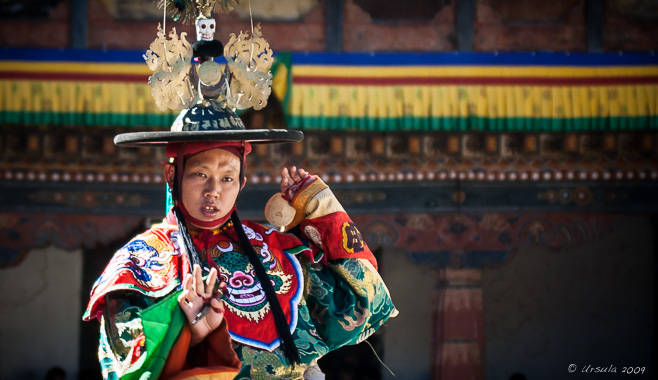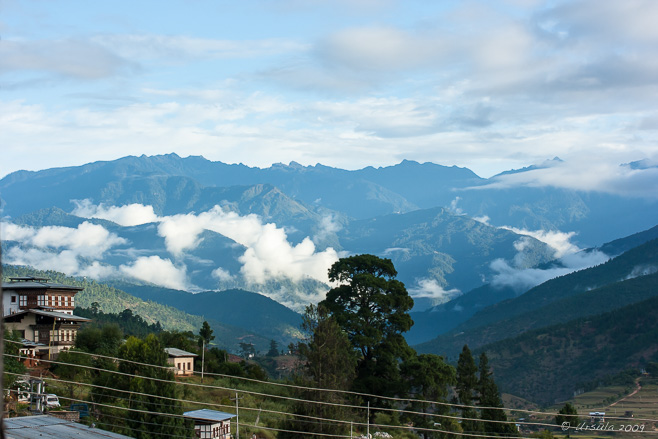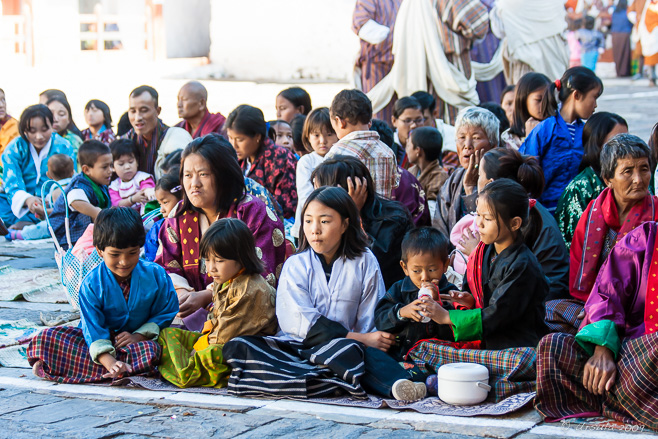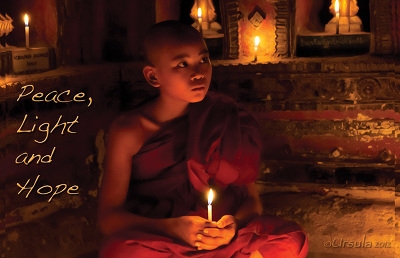
Black Hat Dancer
In the “Shana Cham” – or “Black Hat Dance” – the dancers represent powerful yogis who can destroy and create life: Wangduephodrang Tsechu, Wangduephodrang, Bhutan.
Over the last few weeks, Bhutan, that Haven of Happiness, has been making an appearance in my various electronic news feeds and re-asserting itself into my consciousness. In part, this is because it was around this time of year, six years ago, that I visited.
I was in this beautiful Himalayan Kingdom for two weeks in September 2009, as part of a tour with photographers Gavin Gough and Jackie Rado. We traveled across Western and Central Bhutan in a bus, with our stops timed to coincide with major tsechus (Dzongkha: ཚེས་བཅུ།, literally “day ten”) – annual religious festivals grounded in Tibetan Buddhism. Between three- and five-days long, the festivals comprise a program of Cham dances: costumed, masked dances that depict religious history and moral teachings. Accompanied by percussion instruments, the rhythmic dances are considered a form of meditation and an offering to the gods; they bring merit to participants and audience alike.
The first festival we attended was at Wangduephodrang Dzongkhag Dzong (the “Administrative Fortress” of Wangduephodrang) in Central Bhutan. This is the same temple-fort which made the international press when it burnt to the ground in June 2012. The loss of the original wooden landmark, built between 1638 and 1639, was considered a great tragedy and cause for national mourning. Reconstruction – in the original style but with modern amenities and fire-safety measures – started early 2014 and is expected to be completed by December 2018. In the mean time, the annual Wangduephodrang Tshechu has been held at the nearby Tencholing Army Ground.
So, we were very luck to be there to appreciate the tshechu in its age-old setting.
There are just a few rules to observe for visitors in this very traditional culture: covered arms and legs are expected inside the temple grounds, and no hats are allowed.

Mist in the Valley
It’s a beautiful September morning over the Puna Tsang Chu Valley in Wangduephodrang, Central Bhutan. The weather should be fine for the tshechu.

The Audience
Inside Wangduephodrang Dzongkhag Dzong, villagers in their best traditional dress are already seated on mats on the ground in the courtyard. The morning sun is still throwing long shadows, but the temperature is already rising.

Venerable Monk
The crowd in the courtyard range from the elderly …

Hot Baby
… to the very young, …

Young Girl
… all dressed in their brocaded finery with snacks at the ready.

Getting Dressed
Behind the scenes, dancers get into their elaborate costumes …

The Eye in the Eye
… most of which have macabre masks.

Stag Practicing Back-Bends
Other dancers limber up back stage …

“Shawa Shachi”
… before performing elaborate dances that tell stories …

“Dance of the Stag and Hunter”
… of the battle between Ugyen Rimpoche and the King of the Wind.

Black Hat Dancers
The black hat dancers feature in a number of the cham dances.

Black Hat : Orange Pants
They represent yogis who protect the good in the world and destroy evil.

Black Hat : Red Boots
One of their dances portrays victory over a Tibetan king who tried to destroy Buddhism.

Black Hat : Green Brocade
Their elaborate outfits swirl around them …

Black Hat Dancer
… as they dip and sway, trancelike, …

Black Hat Dancer
… in their rhythmic dances.

Inside Wangduephodrang Temple
Attending a tshechu gives the watchers blessings and washes away their sins.

Fearsome Animal
An ornately dressed dancer in his red mask and horns represents an animal.

Black Hat Dancer
The different black hat dances have different rhythms and steps, …

Black Apron
… and signify different stories – not that I could recognise which was which.

Spidermen at the Tshechu
In a wonderful “clash of cultures”, these boys, wearing Gho (traditional knee-length robes), have their own version of masks to enter the spirit of the dance.

Atsara the “Transcendental Clown”
Not all the dances are serious. The Atsara is a clown with a red wooden mask with a big phallus on top. This one seems to be chasing a tiger.

Watching from the Doorway
The day grows hotter and spectators cling to small patches of shade as they watch the ongoing dances.

Wangduephodrang Dzongkhag Dzong
As I head into the ancient structure and up old wooden stairs, I can’t help but admire the building’s intricate details.

Wolf-Creature
The sun gets higher, and more and more wild creatures come out.

Handsome Father

Handsome Son

Black Hat Motion
The next group of Black Hat dancers come out …

Black Hat in Motion
… swirling in a blur of colour …

Black Hat Motion
… and banging their drums.

Old Woman in Pink
The building’s soft furnishings are as colourful as the clothing worn by the attendees.

Like a Dream
And, the dances continue…

Black Hat Dancers
… with countless players. Because so many masked dancers are needed, registered dancers can be fined if they refuse to perform during festivals.
Bhutan is a conservative country, and was closed to international tourists until 1974 – when 300 people visited. Although I was one of 23,480 tourists in 2009, and there were many non-Bhutanese people at the tshechu we attended, I still felt exceedingly privileged to be there. I remember the heat from the unremitting sun beating on my bare head, and the noise from the constant clash of drums assaulting my ears, but I was aware that I was witnessing a tradition that dates back to the 8th and 9th century, when Padmasambhava (Guru Rinpoche), the father of Tibetan Buddhism, recited mantras and performed rites and dances to conquer local spirits and gods – and to convert opponents of Buddhism.
It is always interesting to return to old photos. Reliving the memories is wonderful – but, as I look at pictures taken so many years ago, I can appreciate how much I have learned about photography and about my equipment since then.
 It just makes me want to go back and do it all again!
It just makes me want to go back and do it all again!
Till then ~
Happy travels!
Photographic notes: pictures taken 26September2009 with my old Canon EOS 400D – edited in Lightroom 5.





































.png)
.jpg)

